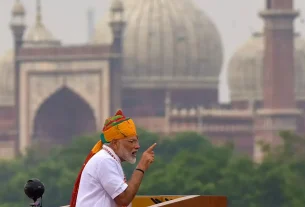Iran’s Supreme leader Ayatollah Khamenei surprised Iranians by appointing Ibrahim Raeesi as the new chief of Iranian judiciary
By Selim Celal
-The Turkey-based writer is an expert on Iran’s foreign policy and domestic politics.
On March 7, 2019, Ayatollah Khamenei, the Supreme leader of Iran surprised Iranians by appointing Ibrahim Raeesi as the new chief of Iranian judiciary. Raeesi replaced Sadiq Larijani, who at one stage was considered a potential successor to Ayatollah Khamenei. A day later Raeesi won another important position as the deputy chair of the Assembly of Experts, a body constitutionally assigned to supervise the Supreme Leader and choose his successor. Interestingly, in the internal voting, his main rival was, again, no other than Sadeq Larijani. Therefore, within two days Raeesi succeeded in knocking out Larijani twice. The appointment of Raeesi was also welcomed by top officials including Hassan Rouhani, his main rival in the 2017 presidential election.
Raeesi’s appointment reveals an important dimension of Iranian politics. Generally, in democracies, the election is a rule of the power game; hence, the fate of a politician is decided in elections. A lot of time and energy is required for a defeated candidate to rise again. But, in Iranian politics, election and power game are two distinct phenomena, thus being defeated in the election does not mean losing the power game. Raeesi’s appointment is a clear example that, in Iranian politics, a defeated candidate can rise to a higher position than his winning rival. In fact, Raeesi must be grateful for not winning the 2017 presidential race. Obviously, a powerful chief of judiciary is far better than an impotent chief of executive. Given that Raeesi’s name is associated with the notorious mass execution of Iranian political prisoners in the 1990s, his appointment shows that public opinion is not held in a high esteem in the Iranian politics.
It is necessary to note that Larijani’s position as chief of judiciary had been extended for five-years in August 2014. It means he still had about six months to the end of his tenure in August 2019. Therefore, the Supreme Leader must have a strong reason for taking such an out-of-schedule decision. Consequently, the key question is what the Supreme Leader is pursuing through Raeesi’s appointment. To answer this question, one would need to make a survey of a chain of recent political developments in Iran.
First, over the last few months, the Supreme Leader replaced several of his provincial representatives with younger clerics under the slogan of “giving opportunity to youngsters”. Though this process had started in 2017, it was accelerated last month. According to a report, over 268 representatives have been replaced by young clergy. The most important commonality between the new appointees is that most of them, on their official websites, mention Ayatollah Khamenei as their main teacher (it is a tradition among the clergy to mention their most prominent teacher and mentor in their biographies).
Second, on 26 Feb, Jawad Zarif, Iran’s foreign affairs minister, resigned in protest for not being informed and invited to the meeting with Bashar al-Assad, who came on a short visit to Tehran. Apart from the blame game as to who was responsible for not informing Zarif, no doubt President Rouhani did not mind that his foreign minister was absent in such a high-profile meeting, while General Qasem Sulaimani (the commander of the GIR Quds Force responsible for military and clandestine operations outside Iran) was sitting next to him.
Third, three days after Raeesi’s appointment, the Supreme Leader awarded General Qasem Suliemani with the “Order of Zolfaghar”, the highest military honor of Iran. Sulaimani is the first person in the history of the Islamic Republic to have been honored with such a prestigious decoration.
Fourth, on March 6, President Rouhani informed his audience during a public speech that the Islamic Republic was in the midst of an economic war, and the Supreme Leader had appointed him (Rouhani) as the commander of the so-called economic war.
Fifth, on March 9, President Rouhani congratulated Raeesi on his appointment. His congratulatory note reads that Raeesi’s appointment is the sign of the Supreme Leader’s confidence in him, and a proof of his (Raeesi’s) excellent performance in his previous positions. These words took many by surprise in that they had heard President Rouhani’s hot speeches against Raeesi during the 2017 presidential election campaign. Referring to Raeesi, on May 8, 2018, Rouhani stated, “people will not accept those who have not known anything but execution and imprisonment over the last 38 years”. “You do not know them, I know them,” he emphasized.
Sixth, on March 11, President Rouhani went for a visit to Iraq. It was his first visit to Iraq since becoming president of the Islamic Republic in 2013. Iraq is too important for Iran to ignore or to delay visiting for six years due to time constraints. Security concerns are also not an appropriate justification, given Iran’s strong security and intelligence presence in that country. The truth is Rouhani had not been allowed to visit Iraq. In a documentary aired by the BBC, ret. General David Petraeus, a former director of the U.S. Central Intelligence Agency (CIA), says that the former Iraqi President (Jalal Talibani) had conveyed him a message from Qasem Sulaimani, who was saying to the American general: “General Petraeus, you should know that I -Qasem Sulaimani- am in control of Iran’s foreign policy on Iraq; and beside Iraq, Iran’s foreign policy toward Syria, Afghanistan, and Ghaza is also in my control”. According to General Petraus, “The point that he [Qasem Sulaimani] wanted to say was that you [General Petraeus] should negotiate with me and forget about Iranian diplomats and others … .” Considering the above narration, one can argue that President Rouhani had simply not been allowed to visit Iraq.
Back to the main question raised at the beginning. Of course it is difficult to read the mind of the Supreme Leader; yet, one should be able to make a logical speculation about what Ayatollah Khamenei has in mind in the light of the abovementioned political developments. Out of these events, as noted by Hassan Shariatmadari, a renowned Iranian analyst, Rouhani has emerged as a commander in the economic front, and Sulaimani as the top military commander, while Raeesi has emerged as a commander of “terror”. It seems that Khamenei has finally succeeded in constructing the right arrangement for a smooth transition of power to his son Mujtaba Khamenei. No doubt, as the deputy chair at the Assembly of Experts, Raeesi would function as the key facilitator. Raeesi will likely be the future head of the Assembly of Experts, a position currently controlled by the 93-year-old Ayatollah Jannati. The Supreme Leader’s move to replace his aged representatives with his young students can be interpreted as an initiative to pave the ground for an eventual Supreme Leadership of a young supreme leader, who is no one else but Mujtaba Khamenei.
Rouhani has been given a free hand to exercise his full executive power in exchange of cooperating with Raeesi and Qasem Sulaimani. Rouhani’s visit to Iraq six years after his presidency, as well as his title of “the commander of the economic war”, should be seen in this context.
For the moment it is the most ideal arrangement that the Supreme Leader could have made. But if lives long enough, he will replace Rouhani with a more loyal president while two pillars of the triangle (Raeesi and Sulaimani) would be fixed for the coming years. No one knows whom the Supreme Leader has in his sleeve as next president. However, he would surely prefer a non-cleric president, someone who could not qualify for the Supreme Leadership position, which is reserved for the clerical class. Of Sulaimani, a non-cleric president, and Raeesi, only the third could qualify for the position, but it would be difficult for him to claim it, as his defeat in the 2017 presidential election would bring the question of legitimacy. In such a situation, the most likely scenario is that Raeesi would not emerge as a “king”, but rather as a “king maker”.
* Opinions expressed in this article are the author’s own and do not necessarily reflect the editorial policy of Media Review Network.





